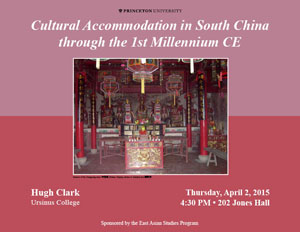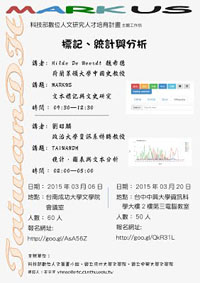港臺近期國學類學術講座展覽(四)
14、Cultural Accommodation in South China through the 1st Millennium CE
時 間:2015年4月2日(周四)16:30
主 講 人:Dr. Hugh Clark(Professor of History & East Asian Studies, Ursinus College)
地 點:Princeton University, Jones Hall, Room 202(Princeton, NJ 08544)
主辦單位:East Asian Studies Program, Princeton University
連結網(wǎng)址:http://www.princeton.edu/eap/events/
內(nèi)容簡介:
The diverse lands south of the Yangtze River lay outside the empire’s cultural heartland long after the assertion of political authority by the Qin empire in the late 3rd century BCE. In the eyes of northern elites who authored the written record, the cultures of the South were considered inferior, “barbaric,” and unworthy of either imitation or engagement. Nevertheless over the course of the 1st millennium CE North and South were increasingly engaged with and familiar with each other.
For centuries if not millennia the standard narrative has presumed that northern culture, the so-called “Confucian” culture overwhelmed and transformed the South, displacing indigenous culture and converting the South into something more nearly akin to the North.
In the present paper the author argues for a different outcome. Through examination of the roots of three cults indigenous to southern Fujian province: the Maternal Ancestress (Mazu), the Great Life-Protecting Lord (Baosheng dadi), and the Lord of Manifest Kindness (Xianhui hou), the author argues that pre-sinitic southern culture had a profound impact on sinitic culture, one that continues to resonate throughout Chinese culture even to the present.
The goal is to challenge the “Confucian” cultural model and a new perspective on what “Chinese culture” means.
※本演講原訂于2月18日舉辦,延期至4月2日。
15、【工作坊】標記、統(tǒng)計與分析工作坊
時 間:2015年3月6日、20日,共2場
主 講 人:Hilde de Weerdt(魏希德,荷蘭萊頓大學中國史教授)、劉昭麟(政大信息科學系特聘教授)
地 點:3月6日于成功大學文學院會議室,20日于中興大學信息大樓2樓第三計算機教室
主辦單位:成功大學文學院、中興大學文學院、科技部數(shù)字人文籌劃小組
聯(lián) 絡 人:有意參加者請徑至在線報名網(wǎng)頁
連結網(wǎng)址:https://sites.google.com/a/ptc.cl.nthu.edu.tw/dhintaiwan/messages
內(nèi)容簡介:
每場工作坊均分為上、下午場次,成大與興大內(nèi)容相同
9:30-12:30(含實做)
講題:MARKUS:文本標記與文史研究
主講人:Hilde de Weerdt(魏希德,荷蘭萊頓大學中國史教授)
數(shù)字工具對于人文學的研究,不只能進行巨量的統(tǒng)計、宏觀趨勢的分析,也能細致的記錄過去文件的樣貌、研究者的成果和心得,讓數(shù)字人文學者可以任意地在宏觀與微觀之間自由移動,進行各式各樣的探索。要做到這點,其中一種方法就是文本標記;亦即,把文件中的重要信息利用標記的方式以利于計算機的辨識,再在這樣的基礎上進行種種的利用。然而,大量的文本要如何進行標記,卻是一個大問題。如果利用人工進行不但曠日廢時,而且常常很難取得一致的標記成果,因此如何讓計算機進行自動標記也就成了信息學者的一大課題。本次我們的講者魏希德要介紹的,就是一種自動標記的系統(tǒng)。她的團隊發(fā)展出的MARKUS(中文直譯為:標記我們吧!)一方面可以利用CBDB(由哈佛大學、北京大學、中研院史語所共同開發(fā)「中國歷代人物傳記數(shù)據(jù)庫」)對輸入的文本或檔案進行人名、地名、官職名、年號的標記;另一方面,也可以讓使用者輸入自己想要標記詞語的清單,然后進行標記;例如,你可以準備一張中藥名稱的清單,然后讓MARKUS把數(shù)據(jù)中的中藥名稱全部標記起來。MARKUS對于想要進行標記文本的文史研究者來講非常便利。歡迎大家參加本次的工作坊,并準備自己的文本進行實做;主辦單位也會準備一些測試文本,讓大家練習。
14:00-17:00(含實做)
講題:TAIWANDH:計算、圖表與文本分析
主講人:劉昭麟(政大信息科學系特聘教授)
數(shù)字科技的力量,一般被了解為具有強大的計算能力,因而時常被文史學者所忽略。然而,計算不但是文史工作者須常常面對的問題、從事的工作,也可能和我們潛藏的敘述判斷有所關聯(lián)。
在這次的工作坊中,劉昭麟老師將為我們展示如何聯(lián)結計算機的計算能力和文本分析的作業(yè),并借著圖表來可視化種種分析的結果。劉老師在演示完后,也將分享他的程序代碼,教我們?nèi)绾巫约簞邮肿龀鲱愃频膽茫员愦蠹铱梢园阉慕?jīng)驗和程序運用在自己的研究和教學。
1.計算機中文檔案的儲存(UTF8、BIG5、GB2312)
2.中文的斷詞、斷句
3.中文詞匯的時序分析
4.相關軟件安裝(Java)
5.G5.oogle Chart 應用
6.Excel 簡單案例
7.中文詞組的時序分析
8.分析角度面面觀
9.具體實作
報導者:毛元亨




